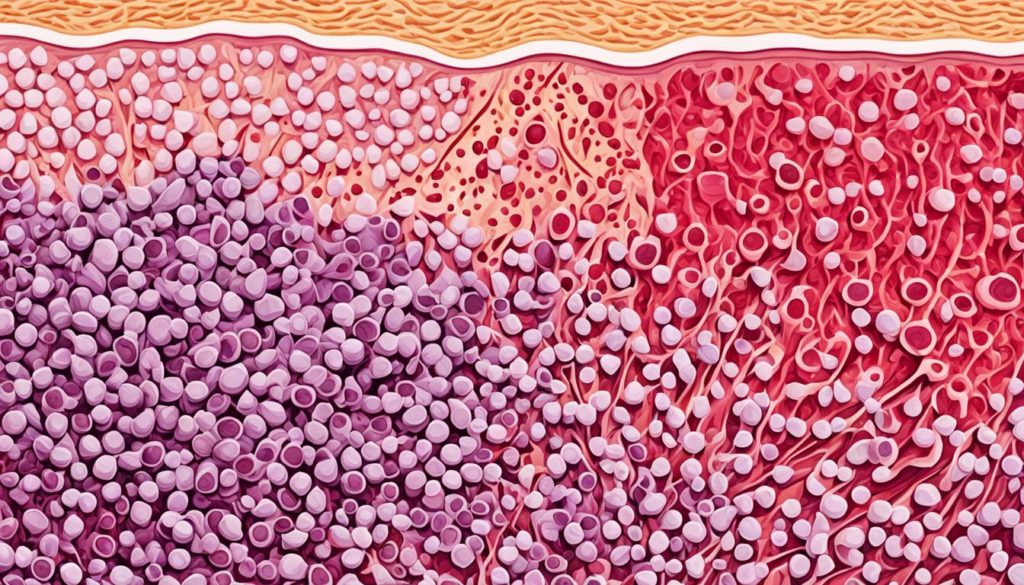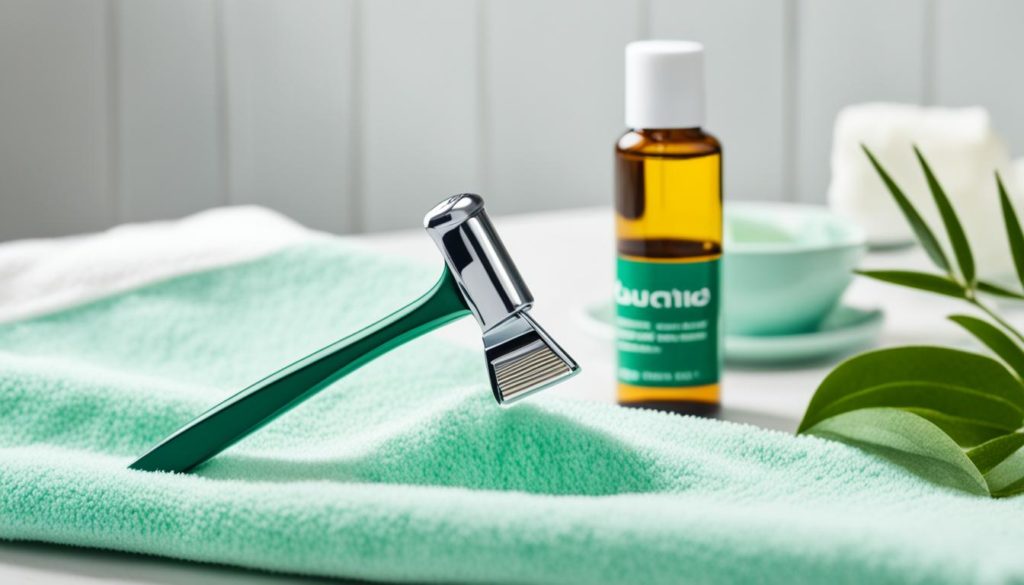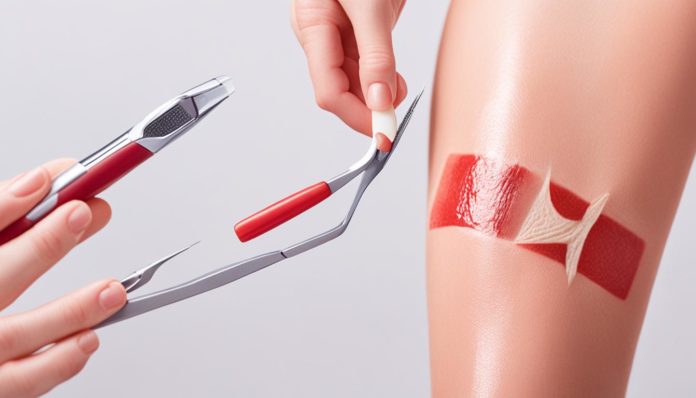Did you know that nearly 60 million Americans deal with ingrown hairs? This skin issue can hurt your daily life and confidence. It’s vital to know about ingrown hair management for smoother skin.
Ingrown hairs happen when hair grows back into the skin, not out. They’re not just annoying; they can cause bigger skin problems. Luckily, there are many hair removal solutions and skin care tips for ingrown hairs to help you.
This article will cover ingrown hairs’ causes and symptoms, and how to prevent them. It will review treatments from simple solutions to advanced procedures. With advice from the American Academy of Dermatology, Mayo Clinic, and Harvard Medical School, you’re set to manage ingrown hairs for better skin.
Key Takeaways
- Understanding the prevalence of ingrown hairs among Americans
- Identifying the causes and symptoms of ingrown hairs
- Implementing effective prevention and treatment strategies
- Exploring the efficacy of various hair removal solutions and skin care tips for ingrown hairs
- Leveraging expert insights from renowned dermatological sources
- Considering advanced treatment options for severe cases of ingrown hairs
Understanding Ingrown Hair: Causes and Symptoms
Ingrown hairs are a common skin issue. They happen when hair grows back into the skin, causing redness, pain, and sometimes infection. It’s important to know why they occur and what they look like to deal with them effectively.

What is Ingrown Hair?
Ingrown hair happens when hair curls back or grows sideways into the skin. This can create a red bump that may look like a pimple. If infected, it turns into a painful sore. People with curly hair often face this problem more.
Common Causes of Ingrown Hair
Improper shaving and dull razors can cause ingrown hairs. Tight clothing also plays a role in making hair follicles grow the wrong way. Other factors include:
- Oil and dead skin build-up: This can block follicles, trapping hairs.
- Hair removal methods: Waxing and epilation can change how hair grows.
- Curly hair: Curly or coarse hair tends to re-enter the skin easier.
Recognizing the Symptoms of Ingrown Hair
Knowing the signs of ingrown hairs can help treat and prevent them. Common symptoms are:
- Redness and swelling: The area may look red and swollen, sometimes with pustules.
- Itching and tenderness: The skin may feel itchy and sensitive.
- Bumps: You might see small, solid bumps or pus-filled lesions.
Understanding ingrown hairs’ causes and symptoms allows for better treatment. Good hair and skin care habits are key in lessening their impact.
Preventative Measures for Ingrown Hair
You can stop ingrown hairs by choosing the right methods and products. Follow best practices to cut down the risk of hairs growing into the skin. This is how you fight off ingrown hairs.
Proper Shaving Techniques
Using the right way to shave is key to avoid ingrown hairs. Always shave with a clean, sharp razor along the direction your hair grows. Use shaving cream to make it glide smoothly and keep hairs out of the skin.

Exfoliation Practices
Exfoliating regularly helps prevent ingrown hairs too. By using soft scrubs or skin-friendly chemicals, you remove dead skin. This lets hairs grow outwards. Do this 2 or 3 times every week to keep your pores clear and ingrown hairs away.
Choosing the Right Hair Removal Products
Picking suitable hair removal products is crucial. Choose ones that are soft on your skin and lessen redness. Look at the ingredients and seek advice on what’s best for your skin type. Making good choices can help you avoid problems with ingrown hairs.
Top Treatments for Ingrown Hair
There are many ways to treat ingrown hairs. You can pick an over-the-counter product, a prescription solution, or use remedies from home. Each method helps soothe the irritation ingrown hairs cause.
Over-the-Counter Solutions
Over-the-counter options can quickly ease the discomfort. They also help stop ingrown hairs from coming back. Look for products with salicylic acid or glycolic acid. These are found in serums and creams made to treat ingrown hairs. They remove dead skin cells, lessen inflammation, and free trapped hairs.
Prescription Treatments
If your situation is more serious, a doctor might suggest prescription options. One option is topical retinoids, like tretinoin. They help your skin renew itself, preventing hairs from growing inward. Doctors can also prescribe antibiotics to fight infection and reduce swelling around the ingrown hair.
At-Home Remedies
Many people like using home remedies for their ease and success. Tea tree oil is a favorite because it fights inflammation and germs. Also, warm compresses make the skin softer. This helps the trapped hairs come out. Keeping your skin exfoliated and moisturized can stop ingrown hairs from forming.
| Treatment Type | Examples | Benefits |
|---|---|---|
| Over-the-Counter Solutions | Salicylic Acid, Glycolic Acid | Reduces inflammation, exfoliates skin |
| Prescription Treatments | Topical Retinoids, Antibiotics | Improves skin cell turnover, reduces infection |
| At-Home Remedies | Tea Tree Oil, Warm Compresses | Anti-inflammatory, promotes hair release |
Best Hair Growth Products for Reducing Ingrown Hair
Choosing the right product is crucial when fighting ingrown hairs. There are many options out there. It’s essential to find the best ones that prevent ingrown hairs effectively.
Product Reviews Roundup
Many hair growth products are known to help with ingrown hairs. They include different ingredients, both natural and man-made. People have different preferences, and these products cater to them.
- Rogaine Foam: Highly recommended for effectiveness of hair growth products in both genders, backed by studies.
- Pura D’or Hair Thinning Therapy Energizing Scalp Serum: Known for its natural ingredients like biotin, it boosts hair thickness.
- Hims Hair Kit: It’s a complete kit celebrated for reducing hair fall and encouraging growth, with many positive reviews.
Natural Versus Synthetic Products
There’s a debate about natural and synthetic hair products. Natural ones like essential oils are gentle and have fewer side effects. Yet, synthetic products can give faster and more visible results. Both have their advantages.
| Product Type | Pros | Cons | Examples |
|---|---|---|---|
| Natural |
|
|
|
| Synthetic |
|
|
|
Effectiveness Comparisons
Several factors affect a product’s success. Consistency is key, according to dermatology reviews. Products with protein can make hair stronger. This helps avoid breakage and ingrown hairs.
Both natural and synthetic products have their benefits. Their effectiveness depends on your hair type and condition. Using natural and scientific products together can be a good strategy. This approach helps reduce ingrown hairs and supports hair health.
Natural Hair Care Solutions
Adding natural care to your hair routine can address ingrown hairs and improve hair and skin health. We will look at herbal remedies, essential oils, and homemade exfoliants.
Herbal Remedies for Ingrown Hair
Herbal remedies are key in caring for your hair naturally. Aloe vera soothes, reduces inflammation, and helps ingrown hairs heal. Witch hazel eases irritation and stops bacteria because it works as an astringent.
Essential Oils and Their Benefits
Essential oils do more than smell good—they have healing effects too. Tea tree oil fights off fungal and bacterial issues, keeping infections at bay. Lavender oil calms the skin, reducing swelling and redness.
DIY Natural Exfoliants
It’s vital to regularly get rid of dead skin to avoid ingrown hairs. Make a scrub with sugar, olive oil, and essential oils. This not only exfoliates but also deeply nourishes your skin.
Use these herbal solutions and essential oils for a better hair care routine. They’ll keep your skin healthy and resilient.
Promoting Healthy Hair Growth to Minimize Ingrown Hair
Healthy hair growth makes your hair look better and helps prevent ingrown hairs. By using good hair care routines and eating well, you can reduce hair problems.
Healthy Hair Growth Tips
For better hair growth, focus on taking care of your hair all around:
- Regularly trim your hair to prevent split ends.
- Reduce the use of heat styling tools to minimize damage.
- Adopt proper brushing techniques to avoid breakage.
- Ensure scalp care for hair growth by keeping it clean and hydrated.
Diet and Nutrition for Hair Health
Eating a balanced diet helps your hair grow and stops ingrown hairs. Focus on these nutrients:
- Protein: It’s needed to make keratin, which helps hair structure.
- Vitamins: Vitamins A, C, D, and E help your hair and scalp stay healthy.
- Minerals: Iron, zinc, and omega-3s make your hair follicles strong.
Eating foods with these nutrients boosts your hair health and lowers ingrown hair chances. For tips on treating and preventing ingrown hairs, check outCleveland Clinic’s Guide to IngrownHair.
Scalp Care Practices
Taking care of your scalp is key for hair growth and avoiding ingrown hairs:
- Use gentle, sulfate-free shampoos to cleanse the scalp without stripping natural oils.
- Regular scalp massages improve blood circulation, boosting hair follicle health.
- Exfoliate the scalp weekly to remove dead skin cells and prevent clogged follicles.
By adopting these practices, your scalp health and hair growth will improve. Focusing on your hair care will also help prevent ingrown hairs.
Understanding the Link Between Hair Regrowth and Ingrown Hair
The way hair grows back affects ingrown hairs. Knowing how hair grows and links to ingrown hairs helps tackle the problem.
Cycle of Hair Regrowth
Hair grows in three phases: Anagen (growth), Catagen (transitional), and Telogen (resting). Hair grows, detaches, and falls out in these stages. Problems in these phases can cause ingrown hairs. This happens when the hair curls back into the skin.
Factors Affecting Hair Follicles
Different things influence hair follicles and ingrown hairs. These include hormonal changes, genetics, and the environment. Changes in hormones, like during puberty, can change how hair grows. Genes affect hair type and growth speed. Things like air pollution make hair follicles weaker.
| Factor | Impact on Hair Follicles | Risk of Ingrown Hairs |
|---|---|---|
| Hormonal Imbalance | Alters hair growth cycle | High |
| Genetics | Determines hair texture | Medium |
| Environmental Exposure | Weakens hair follicles | Low |
Preventing Hair Follicle Damage
It’s crucial to avoid hair damage to prevent ingrown hairs. Good hair care and the right way to remove hair help a lot. Using sharp blades and moisturizing when shaving protects follicles. Plus, knowing why ingrown hairs happen and preventing them leads to healthier hair growth and fewer problems. Click here to learn more.
Advanced Dermatological Procedures
There are advanced solutions for tough skin issues. This section talks about three top treatments for ingrown hair problems.
Laser Hair Removal
Laser hair removal gets rid of unwanted hair with light. It’s known for being precise, fast, and lasting. Lasers in Surgery and Medicine showed it’s great against ingrown hairs.
Dermatologist-Recommended Treatments
Experts choose creams and medicines based on your skin. The American Society for Dermatologic Surgery says specific treatments reduce swelling and stop ingrown hairs from coming back. With an expert’s help, you get the best care.
Chemical Peels
Chemical peels can also help with ingrown hairs. They remove dead skin, allowing new cells to grow. This stops hairs from getting trapped. The Journal of Clinical and Aesthetic Dermatology found they keep skin smooth and reduce ingrown hairs.
| Treatment | Benefits | Recommended For |
|---|---|---|
| Laser Hair Removal | Precise, fast, long-lasting | Multiple skin types, persistent ingrown hairs |
| Dermatologist-Recommended Treatments | Targeted, professional oversight | Severe or recurrent ingrown hairs |
| Chemical Peels | Exfoliation, promotes new cell growth | Individuals seeking smoother skin |
Conclusion
To handle ingrown hairs well, it’s vital to know why they happen and how to treat them. This article showed why it’s key to shave right, scrub your skin, and pick the best hair removal stuff. This way, you can really cut down on ingrown hairs.
Also, we talked about the best ways to treat ingrown hairs. There are simple treatments you can buy, prescription options, and home remedies. For those wanting more, treatments like laser removal and chemical peels by doctors are helpful. Using natural hair care, like herbs and homemade scrubs, also helps your skin.
It’s important to encourage healthy hair growth to avoid ingrown hairs. By eating well, taking care of your scalp, and following hair growth advice, you can help your hair grow better. Knowing how hair grows back and stopping damage to hair roots is also key to stopping hair loss and getting good results.
In the end, using these hair growth tips and treatments means taking great care of your skin in your own way. We suggest you keep learning about these methods. Use them to handle ingrown hairs well and make your skin look and feel great.
FAQ
What is the most effective method for ingrown hair management?
To manage ingrown hairs effectively, use proper shaving methods, exfoliate regularly, and choose the right hair removal products. This keeps hairs from growing back into the skin. Using certain over-the-counter and prescription treatments can also help.
How can I prevent ingrown hairs?
To prevent ingrown hairs, shave in the direction hair grows using a sharp razor. Exfoliating often and using suitable hair removal products also help. Wearing loose clothes and using natural hair care solutions are good practices too.
What are the common causes of ingrown hairs?
Ingrown hairs can happen because of poor shaving methods, dull razors, and certain hair removal techniques. Your genetics, hair type, and skin type might affect it too. Look out for signs like redness and bumps to treat them early.
Are there natural remedies for treating ingrown hairs?
Yes, there are natural treatments for ingrown hairs. Options include herbal remedies, tea tree oil for its anti-inflammatory effects, and homemade sugar scrubs. These methods improve skin health and relieve ingrown hair symptoms.
What are some effective over-the-counter treatments for ingrown hairs?
For ingrown hairs, over-the-counter options include creams with salicylic or glycolic acid to exfoliate and reduce swelling. Hydrocortisone cream helps with redness and itch. Always follow the product directions or ask a healthcare professional for guidance.
How do prescription treatments for ingrown hairs work?
Prescription treatments use stronger ingredients like retinoids, antibiotics, and corticosteroids. They quicken skin renewal and shrink swelling. These options are for when you need something more effective than store-bought products.
What role does diet play in promoting healthy hair growth?
Eating well is key to healthy hair and less risk of ingrown hairs. A balanced diet should have vitamins A, C, D, E, zinc, and iron. Don’t forget proteins and omega-3s which are crucial for strong hair follicles.
Can laser hair removal help with ingrown hairs?
Yes, laser treatments can significantly reduce ingrown hairs. They stop hair from growing back by targeting the follicles with laser beams. A dermatologist can advise if it’s right for you.
What are the benefits of using natural hair care products?
Natural hair care products are safer for sensitive skin and don’t have harsh chemicals. Ingredients like aloe vera and coconut oil soothe and nourish the skin. They’re good for keeping skin healthy and free from ingrown hair irritation.
How do I choose the right hair removal product to prevent ingrown hairs?
Pick hair removal products meant for sensitive skin that don’t cause hair breakage. Look for those with moisturizing elements and skin exfoliants. Reading reviews and consulting dermatologists can help decide on the best option.


